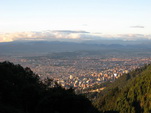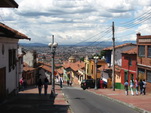Bogota
Bogota (Spanish: Bogotá) is the capital of Colombia. The population lies between 6.2 and 7.5 million men, according to a 2005 count there were 7,321,831 that year.
Geography
 Overview of Bogota
Overview of Bogota
The city lies at 2600 meters altitude on a mountain plateau in the eastern mountains of the Andes. The city is the Capital District and therefore falls outside the departments of Colombia. However, Bogota is the capital of the department of Cundinamarca, by wich it is almost completely surrounded.
While Bogota lies almost on the equator is the average daily temperature by the high altitude of only 18 degrees (at night 9 degrees).
History
Santa Fe de Bogota was founded in 1538 by Gonzalo Jimenez de Quesada. The name of the city comes from Bacata, a resident of the Muisca Indians. Bogota is actually founded twice. The first time was when Quesada on August 6, 1538 with a Holy Mass was baptized twelve farms Santafé. Then symbolically pulled grass from the ground and challenged anyone who would object to the foundation. The second and official foundation took place on April 27, 1539 when Quesada with Sebastián de Belalcázar and Nikolaus Feder Mann complied to the terms of the Spanish Crown by installing a mayor and council, identifying the streets and building lots, and defining the Plaza Mayor. At the place where Bogota was founded in 1538 is now the Cathedral to the Plaza de Bolivar Primada.
Until 1940 the city grew slowly, but has since attracted many Colombians from the country to the city in search of greater economic prosperity. Bogota is the most important center of Colombia, both politically and financially and culturally. Bogota is a modern, ever-growing metropolis with high-rise buildings in the center, surrounded by suburbs with mostly low-rise.
Capital
 Bogota - La Candelaria
Bogota - La Candelaria
Bogota in 1717 became the capital of the Spanish colony of New Granada and even after independence from Spain was the capital of the country. Due to its far remoteness from the sea it was not immediately obvious that this city would become the capital of Colombia. The plateau was home to the indigenous Indians Muisca, a farming community, and they turned to an abundant source of colonial labor. This economic advantage was the capital city of the country. The colonial city can still be found in the Candelaria district.
The city is listed not only the capital of Colombia, but also of the department Cundinamarca, although it is not formally a part from it. Cundinamarca is the only department whose capital is defined by the national constitution. This means that a relocation of the capital requires a constitutional amendment and not a simple decision of the Provincial Assembly.
Infrastructure
Bogota's is connected through the Eldorado airport and the Pan-American Highway to other major centers. Although the city has a vast network of roads one of the major problems is traffic congestion. Bogota therefore applies a restrictive car policy: on turn cars with certain license plates are forbidden to drive during peak hours. The current public transport, taxis and buses of all shapes and sizes, where unable to provide a solution for congestion and transport problem in the city. For several years Bogota therefore is building a new network of closed lanes exclusively for the bus system Transmilenio. That can best be compared to a subway, were it not is underground and uses buses with diesel engines. The network of Transmilenio is constantly growing.
The street pattern of the city is like a rectangular network: the streets of north-south direction are called carreras, perpendicular to the streets in an east-west direction called calles. Carreras and calles generally have no name, but a number. The house numbering is based upon it. A home address as Calle 42 # 15-34 means that the house is located in Calle 42, 34 meters from the corner of Carrera 15 (towards carrera 16).